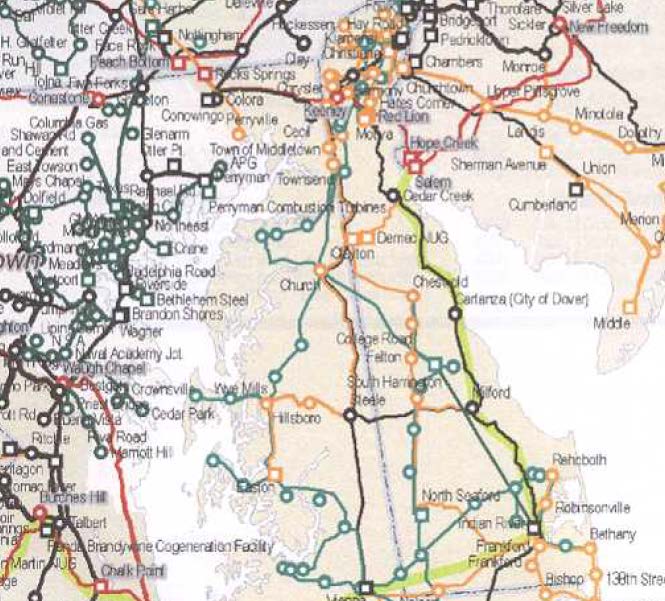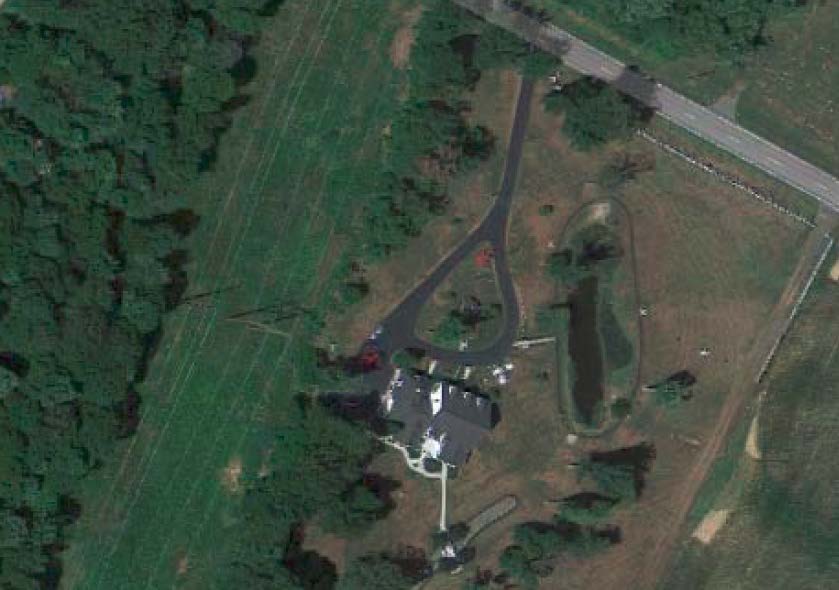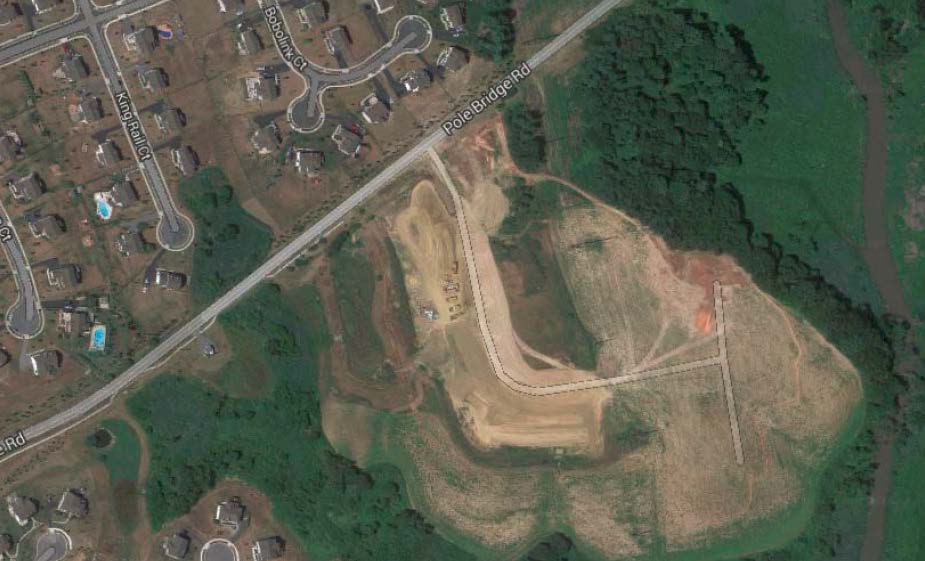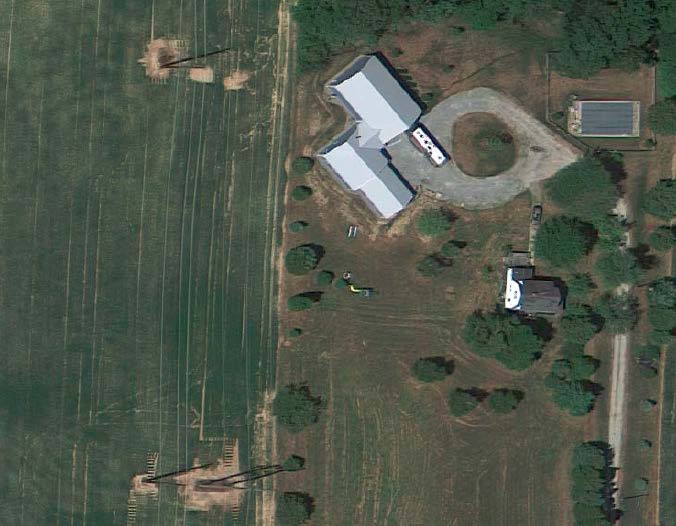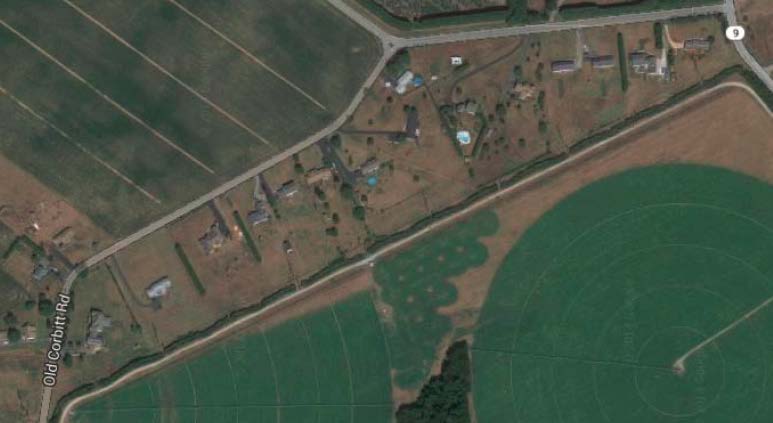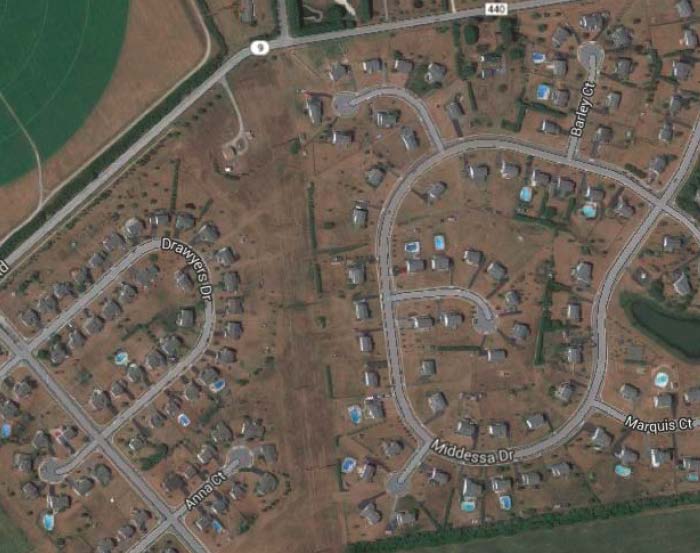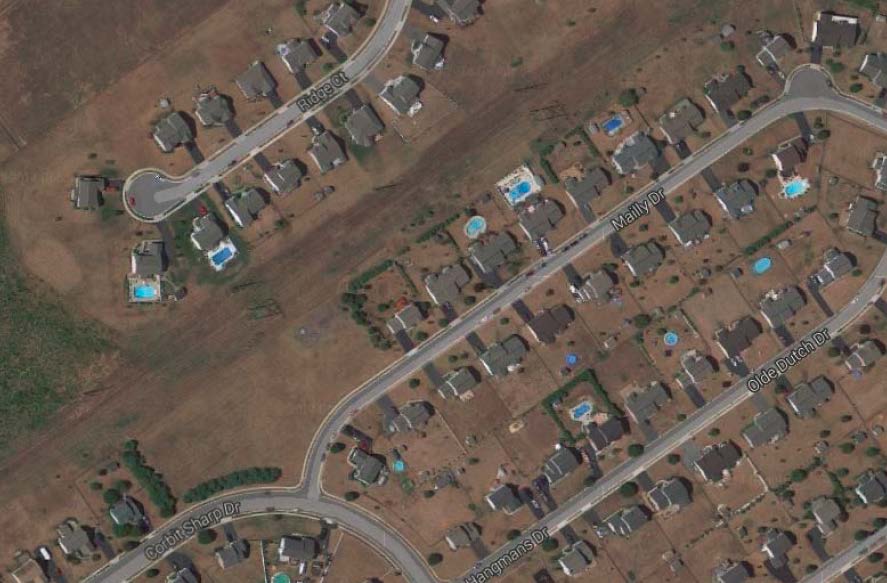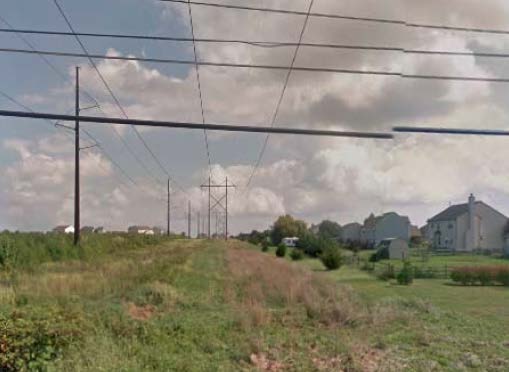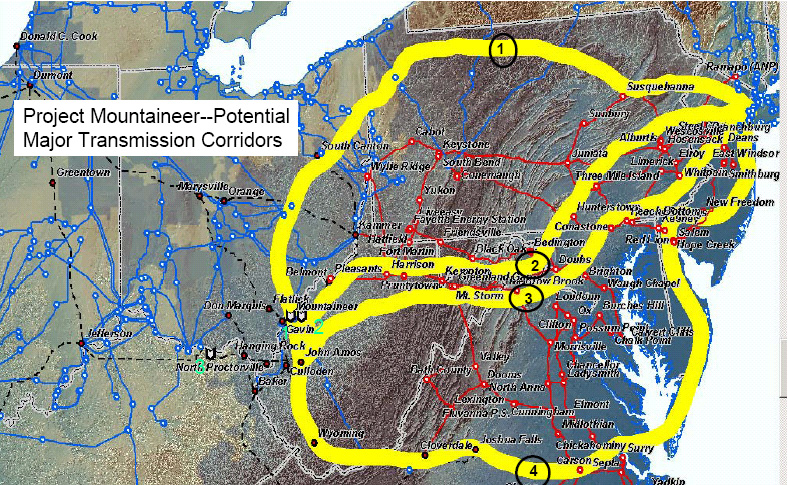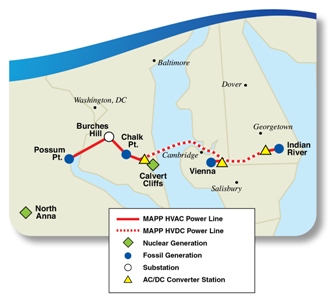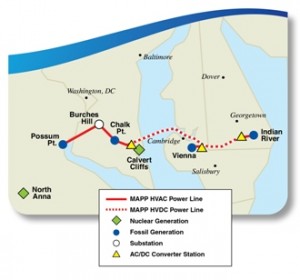Where were you the night of June 25, 1998?
January 13th, 2020

The June 25, 1998 blackout report needs to be on the interwebs available to the world.
June 25, 1998? That’s the night of the transmission fail that disconnected the Midwest from the Eastern Interconnect. That question was asked by Minnesota Power’s attorney of each and every witness, I think other than MP, but maybe MP witnesses too, in the Arrowhead transmission project hearing, circa 1999-2000. There were cries of “Hospitals will go dark without the Arrowhead project,” “We’re going to freeze in the dark in an incubator” which became “We’re going to freeze in the dark on a respirator without a job” — it was so histrionic.
The Arrowhead transmission project was project 13J of the WRAO Report, and the WIREs Report, which presented many transmission lines, but chose the Arrowhead transmission project as the “be all and end all” of transmission in the Midwest, that it would fix all the transmission problems:
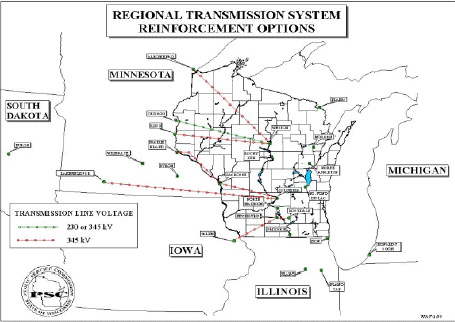
The hearing went forward, 2 weeks in Minnesota, where MP got an exemption from Minnesota Power Plant siting law, and for TWO MONTHS in Wisconsin, for Round 1, then 2 weeks after the cost went way up, and another 3-5 days of hearing later when cost went up again. They got their permit, it’s up…
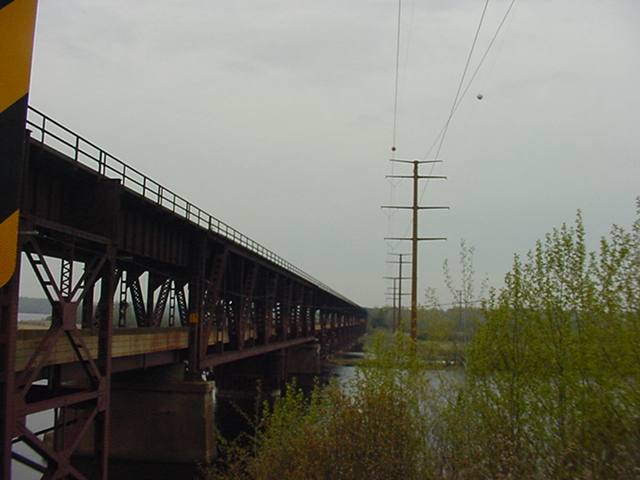
But in that first hearing, I did get to introduce the report that showed that the June 25, 1998, blackout was NOT caused by too little capacity, it was not caused by an unreliable transmission system. It was caused by corporate greed, transmission operators running the Prairie Island-Byron 345kV’s TCEX flow over the limit, disregarding operating guides, and disregarding requests and demands to ramp the power down, violating MAPP Operating Standards and NERC Operating Policies. SHAME, NSP, SHAME!!! And MP was so tacky, trying to attribute their desire for bulk power transfer to the blackout, that the Arrowhead project would save us. Yeah, right…
Here’s the report, below, it’s a gem, I’m posting this today because I’m shoveling off my desk and there are a lot of gems here, so posting them will get them out into the world in perpetuity — can’t disappear something from the internet! Scanning them in is taking a while, a royal and dusty pain in the patoot, but just for you inquiring minds, HERE IT IS:
Here are a couple snippets, starting with p. 2:
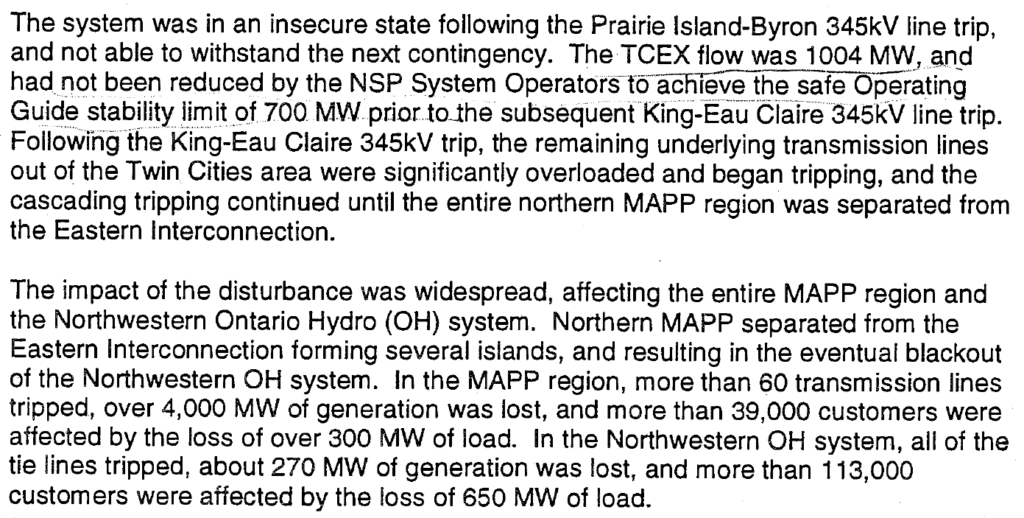

Bottom line?
OPERATE WITHIN OPERATING GUIDE LIMITS!!

DOH!
The report goes on and on with stupid human tricks – the flow was NOT reduced by NSP System Operators:

From pps 10-11:


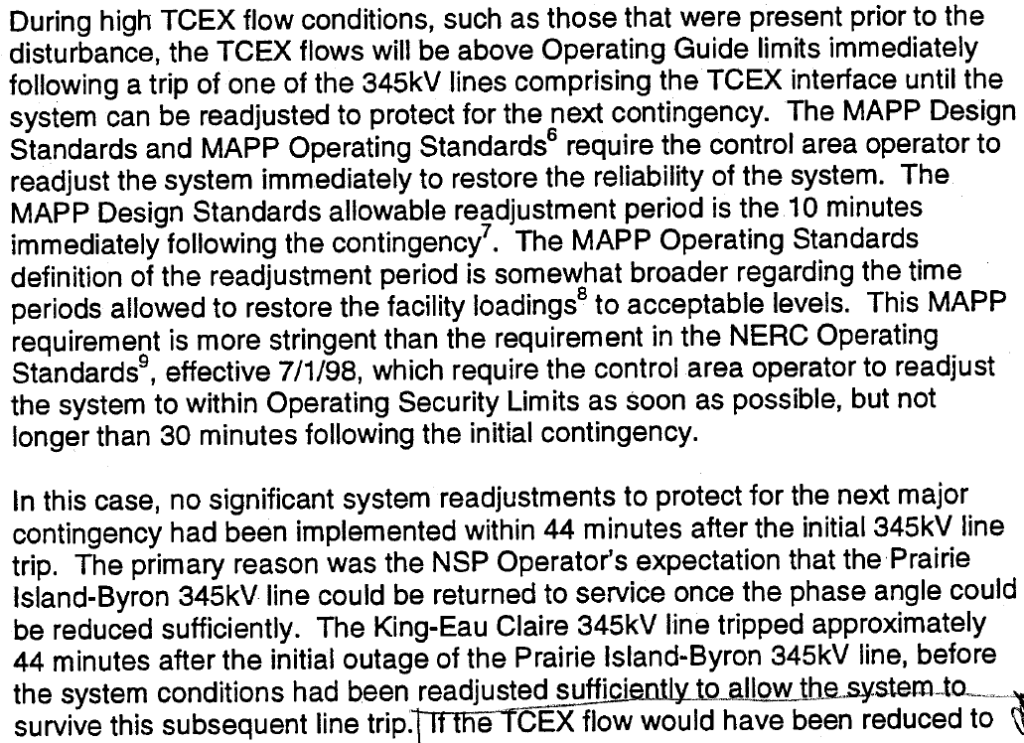

So if the operators had been doing the job, not focused on keeping that line operating with all that power flowing through it, selling that power, the blackout may not have happened. Great…
And for some reason, NSP operators were not communicating:

300 MW above the operating guide limits:
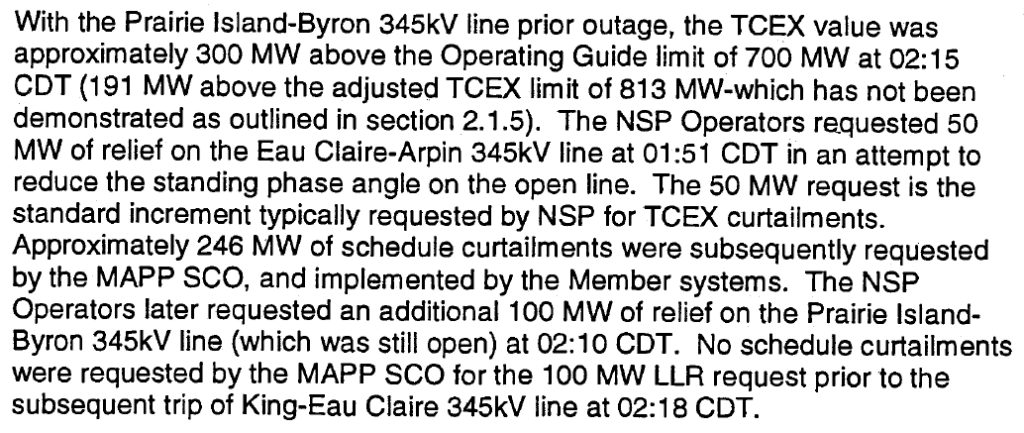
OPERATE WITHIN OPERATING GUIDE LIMITS!! DOH!
Operator error is a too-generous way to put it — but for the efforts to NOT reduce power flows, the inadequate response of system operators and their failure to communicate the degree of the problem, the blackout may not have happened. And then utilities have the nerve to say that because of the June 25, 1998 blackout, we need the 13j Arrowhead transmission project?
Delmarva Power to rebuild transmission in DE?
January 3rd, 2015
Delaware’s a small state, and it’s just the wrong shape for getting a good transmission map. Click the above one for a larger view, but it’s still hard to see. But check it out! Take a look at that black line, stretching from Red Lion down to Milford. That’s the 230 kV line that Delmarva Power wants to rebuild. If they play this as I think they will (please prove me wrong), they could use this “rebuild” to significantly increase transfer capacity, which given the withdrawal of the Mid-Alantic Power Pathway (MAPP) transmission project, that’s something to watch for.
Public meeting about transmission line rebuild
7 p.m. Wednesday, Jan. 7, 2015
Odessa Fire Company
304 Main St., Odessa, Delaware
Hosted by Delmarva Power
There’s essentially no regulation of transmission in Delaware, a fact that’s hard to believe given the impacts and power associated with transmission. This project is intended to go right down an existing easement, but the original line was built 50 years ago, and there’s been a lot of development in Delaware since then. Look at the map, and there’s a lot of development right next to this transmission line. Do you think these folks know anything about this transmission plan? Do you think anyone along that easement is getting direct notice about this???
At first glance, a couple of things occur to me.
- Rebuild? As always, I want to know the details. they say it will still be at 230 kV. Let’s have the conductor specs, particularly. How big a conductor are they using, ACSR or ACSS or higher capacity? Will they be rebuild as a single or double circuit, and will it be bundled or not? Here’s the photo of the line, photo from Snooze Urinal, and it’s as it looks to me from driving under it numerous times on the way to/fro Port Penn:
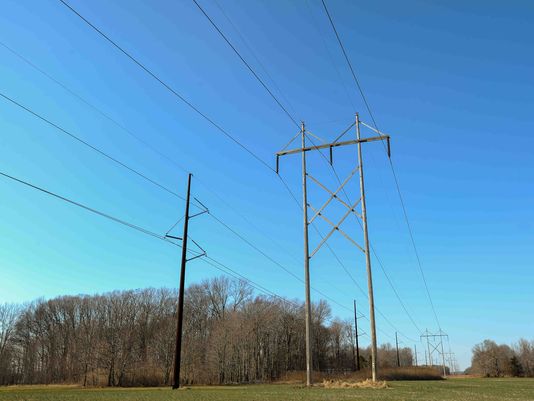 Photo from The News Journal, delawareonline.com
Photo from The News Journal, delawareonline.com
- Use of existing easement or extending beyond? In their press release, there’s something disturbing about how they say they’re going to build this thing:
So looking at this photo above, it’s facing north, the H-frames are on the east side, the monopole on the west, and the News Journal report says:
How is that possible? The H-frames have been there a long time, and rather recently they added the monopole next to it. Now now this will be “built along the eastern border of the existing right-of-way.” EH? Here’s an example, at the intersection of Port Penn Rd. and the line, the “east” is on right on this photo/map (click photo for larger version):
This is what it looks like at the road, looking down the easement with home on the left:
And here’s another example, at the intersection of Pole Bridge Rd. and the transmission lines, also on the way to/fro Port Penn, note the new subdivision roads, Waterbird Lane and Marsh Hawk Court:
Here’s another at 955 Vance Neck Rd (the road is just to the south):
Let’s keep going further south along the easement. Here are homes along Old Corbett Rd. near the intersection of Hwy. 9 — note it’s turned around to fit better, the “easterly” direction they’ll build into is the area towards the homes:
Here’s another subdivision on the other side of Hwy. 9, and the homes along Middessa Drive:
Just a little further south, where the line turns southwesterly, the line is abutted by the homes on Mailly Drive and Corbit Sharp Drive:
Here’s what that easement looks like — build this new thing on the easterly border of the easement? I think not!
And this northern Red Lion to Milford section of the transmission “rebuild” terminates at the Cedar Creek substation, technically in Townsend:
Again, do you think these folks know anything about this transmission plan? Do you think anyone along that easement is getting direct notice about this???
Here’s Delmarva’s Press Release:
Press Release 12/23/2014 – Delmarva Power Project to Benefit Delaware
Here’s the report from the News Journal:
Delmarva to brief public on transmission line rehab
The electrical spine of Delaware is set for a $70 million rehabilitation.
The utility will host a public meeting to brief the community on the project on Wednesday in Odessa.
Contact Staff Writer Xerxes Wilson at (302) 324-2787 or xwilson@delawareonline.com.
For more information:
Delmarva Power will host a public meeting at 7 p.m. Wednesday, Jan. 7, at the Odessa Fire Company, 304 Main St. in Odessa.
MAPP is dead, dead, dead
August 8th, 2012
Just in today from PEPCO:
All,
I am writing to provide an update on PHI’s proposed Mid Atlantic Power Pathway (MAPP) project.
Today PJM issued the final results of its 2012 transmission analysis and due to factors such as lower load growth from the sluggish economy, the installation of new gas fired power plants, and the increase in demand response programs, no reliability violations were identified within the transmission planning window. As a result, the PJM Transmission Expansion Advisory Committee (TEAC) issued a recommendation that the MAPP project be canceled. On August 24, 2012, the PJM Board of Managers will meet to make a final decision on the TEAC’s recommendation.
I would like to express my sincere appreciation for your interest and participation in the MAPP project over the past few years.
Thank you,
Mark Okonowicz
MAPP – Environmental Coordinator
Pepco Holdings, Inc.
P – 302-283-6115
C – 302-463-5438
mark.okonowicz@pepcoholdings.com
This is after their bogus claims, in 2008, of skyrocketing peak demand (utterly unsupported by fact) from a June 25, 2008 MAPP Presentation found on the DNREC site — this “forecast” is so outrageous, and cancellation is SO HILARIOUS in light of Todd Goodman’s objections to my chalenging demand:
So let’s take a step back – what is MAPP?
No, this isn’t about the Mid-Continent Area Power Pool… it’s the Mid-Atlantic Power Pathway (MAPP), and it is DEAD!
The Mid-Atlantic Power Pathway, a transmission line that was part of “Project Mountaineer,” a coal transmission web that was hatched at a 2005 FERC meeting. MAPP was the NE part of line 4, below (Susquehanna-Roseland is the eastern part of line 1):
Here’s the transcript of that meeting, too scary, but it’s important to read this:
They tried and tried and tried, against evidence, to ram all these projects through. The did manage to get the first one through, the TrAIL (Trans-Allegheny Interstate Line) project, but PATH (Potomac-Appalachian Transmission Highline) is dead, Susquehanna-Roseland is permitted but not yet built…
Slowly but surely, PJM is admitting that transmission is not “needed” by any measure. With MAPP, first they planned it as above, in the first map, and then they eliminated the part in Delaware from Indian River to Salem/Hope Creek nuclear plants:
Despite this, Delaware’s DNREC issued permits for part of this project in Sussex County, Delaware! Whatever for? Why would they do this? Aren’t they paying attention to things electrical? DNREC should know this is not needed
Here is today’s good news — PJM’s latest review, just released, showing NO THERMAL VIOLATIONS — DUH:
Here are two slides that say it all, the first focused on PATH but including MAPP, and the second, the “MAPP Project Analysis” results:
And the bottom line? Another DUH, GOODBYE PATH AND GOODBYE MAPP:
Once again, we’re proven right. How long have we been fighting all these transmission projects, how much time, effort and money showing it’s not needed, even when using INDUSTRY studies, documentation, forecasts. All their claims of need are fabricated, reverse-engineering to get the result they want, billions of dollars of PRIVATE INTEREST, not PUBLIC interest, projects, built on the backs of landowners, with a FERC guaranteed 12+% rate of return for the owners/builders/developers.
The down side is the ratepayers are probably going to be hit with all these development costs because so many jurisdictions allow recovery for “CWP,” construction work in progress. So we get screwed, but not as badly as if they had built the projects.
Like CapX 2020, this project was another of those personal projects. MAPP was originally heading up through Delaware to the Salem/Hope Creek nuclear plants, and the Delaware part would have gone near us in Port Penn, we’re right across the Delaware River from Salem/Hope Creek. They should know better than to try something like that!
MAPP line goes for FEDERAL LOAN GUARANTEES
March 7th, 2011
Remember the Mid-Atlantic Power Pathway?
A while back, PEPCO or PHI, announced that they would not be moving forward with this project.
Lower energy production puts brakes on powerlines – News Journal January 24, 2010
Now they’re going for DOE federally guaranteed loans… funny how that works. A project that is delayed and delayed because it is NOT needed, that they are NOT willing to finance on their own, that they can’t or won’t get market financing for it, that they can’t or won’t finance themselves, and so now they want federal financing? Sounds like the DOE needs some lessons from Fannie Mae about financing outrageous and unsupportable projects!
Thinking about this, and what that pro forma must look like, I called the DOE rep about getting a copy of the loan application. Seems it’s not online and it’s not public and I’m going to have to do a FOIA request to get it, and that it will be redacted. OK, whatever… will keep you all posted about that!
Here are the official notices of the financing arrangement and the scoping meetings:
And Pepco’s MAPP site has the announcement on their “Events” page:
The public hearings are as follows:
Date: Tuesday, March 22, 2011
Presentation of Project Description & Oral Comments: 7:00 pm
Place: Holiday Inn Express – Prince Frederick
355 Merrimac Court
Prince Frederick, MD 20678Date: Wednesday, March 23, 2011
Presentation of Project Description & Oral Comments: 7:00 pm
Place: Cambridge-South Dorchester High School
2475 Maple Dam Road
Cambridge, MD 21613Date: Thursday, March 24, 2011
Presentation of Project Description & Oral Comments: 7:00 pm
Place: Indian River Senior Center
214 Irons Ave
Millsboro, DE 19966
Be there or be square!
PJM shell game continues
October 14th, 2010
This week, PJM has “decided” that part of the humongous 500kV buildout isn’t necessary. Well DUH, but…
PJM Press Release – PJM Board authorizes $18 billion in transmission upgrades
And so please explain why the headline isn’t “PJM Board cancels 500-kilovolt (kV) line connecting the Branchburg, Roseland and Hudson substations in northern New Jersey.”
From that PJM board meeting, there was a presentation that looks like a corporate-style WAKE UP call:
Meanwhile, I’m trying to find the primary documentation, something with specifics about what was “approved” and what was “removed” and the basis for it… nada… nothing that I can find on the site. Something else irritating is that when I’m looking up documents on the PJM site, I often just get a blank black page, particularly from the TEAC site.
One interesting presentation was about a Market Efficiency Analysis, in 2014 without Mid-Atlantic Power Pathway (MAPP), Potomac-Appalachian Transmission Highline (PATH), Branchburg-Roseland-Hudson and Susquehanna-Roseland, and from then on without the Branchburg, Roseland and Hudson line:
2010 Market Efficiency Analysis Results Updates – October 6, 2010
And when I try to get closer to the Northern NJ documentation… well, tell me if YOU can get anything:
“File is damaged and could not be repaired.” So I called the number on the PJM press release to see… and was told they’ll call back. Yes, we shall see…
